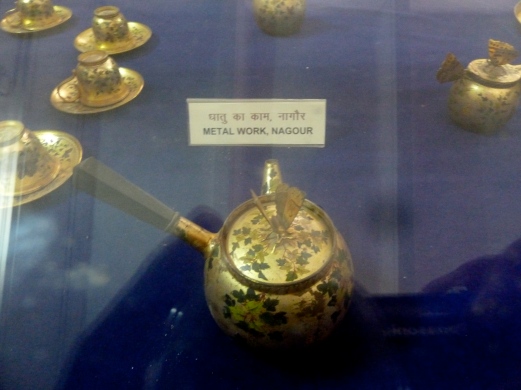The Sardar Government Museum is hands-down the least informative museum I’ve ever visited. I spent an hour browsing its dimly lit displays, and I saw many wonderful and fascinating artifacts that would not have been out of place at the Louvre or the Met. But I had almost no idea what they were.
Before my visit, I read in my Lonely Planet guide that the Sardar Museum was “frozen in the 19th century” with “ill-labelled exhibits in dusty cabinets.” I soon found that ill-labelled was an understatement. Each exhibit had a single placard with a cryptically brief description in blunt capital letters. For instance, “METAL WORK” or “DIFFERENT KINDS OF LOCKS.” Any further information was nowhere to be found, possibly lost forever.
The first room I entered was full of pitiful and disturbing taxidermy, including a humongous crocodile, some sort of horned buck, and a pair of tigers positioned in a fierce wrestling match. The tigers were labelled twice, with one label reading, “TWO TIGERS FIGHTING,” and another reading, “TWO LIONS FIGHTING.”
But the stuffed birds were by far the worst. Either they were prepared sloppily—possibly while still alive—or the ravages of time had taken a severe toll. None of the specimens bore much resemblance to actual, living avifauna. Feathers were sticking out in all directions, the colors had faded to putrid shades of brown, and many species were lacking eyes or other crucial parts. One dove was entirely missing its head.
Behind a case of mutilated birds, I saw a man sitting cross-legged and eating his lunch. His uniform suggested he was a museum guard. I nodded hello, but he barely registered my existence.
The other rooms were an improvement, at least in terms of content. One was filled with antique knives and rifles, another had carvings of shell, stone, and ivory, and a third displayed statues of Hindu gods dating back to 11th and 12th centuries.
The most intriguing exhibit was a case of about fifty figurines representing different scenarios. It was labeled, “THE SOCIAL LIFE OF MARWAR.” According to the display, typical activities in the Marwar region included plowing fields, playing games, and having your livestock get viciously mauled by tigers. I would have been very interested in learning more about Marwari social life, but as I mentioned earlier, providing information was not a strength of the Sardar Museum.

For a child in Marwar, having an active social life means playing on a see-saw. For a cow, it means getting violently devoured by predator.
When I reached a display of blue and white ceramics labelled “POTTRY,” I saw two female guards lying flat on the ground. I watched them for signs of breathing, worried that they had died from heat or boredom, and was relieved to see that they made a few slight movements. Like the guard from the taxidermy room, they paid no attention to me.
The highlight of the museum was a miniature golden swing, adorned with images of peacocks and human figures. It seemed like a tremendously valuable item, but the display gave no explanation of its background or significance. Who had owned it? Why was it built? What was it used for?
All of the objects in the Sardar Museum were surrounded with an air of mystery, giving them a certain allure that’s not present in larger, better curated institutions. Aside from the taxidermy room, the museum was kind of charming (although it was most likely haunted by feathered ghosts upset their corpses had been mistreated, like some sort of perverse combination of The Birds and Poltergeist). Normally when I visit a museum, I spend as much time reading about the exhibits as I do looking at them, but the Sardar Museum lets the objects speak for themselves. This minimalist approach might be unintentional, but strangely, it works.
___________________________________
I wasn’t sure if photography was allowed in the museum, so I made a game of trying to take photos without being noticed. Given the fatigue and apathy of the guards, it wasn’t much of a challenge:

I think “Nagour” is supposed to be “Nagaur,” a nearby city in Rajasthan:
http://en.wikipedia.org/wiki/Nagaur
NOTE: Photos of the bird taxidermy were too grotesque to even consider including in this post.





Sounds like an interesting day out ! 🙂
That’s absolutely nuts, Ben. Priceless. Two guards actually asleep on the floor? I love it.
Any chance that a vegan friend might ask for more odd-ball pictures if you have them? Not that he would want them.
I included all the museum pictures that I could take discreetly. The rest are hard to distinguish, although the taxidermy was pretty hard to distinguish in the first place.
I can send other oddball pictures via email.